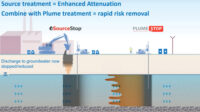Study outlines long-term PFAS solution using colloidal activated carbon for airport site remediation
A new study featured in the Winter 2022 issue of the REMEDIATION Journal assessed the factors affecting in situ colloidal activated carbon (CAC) remediation of PFAS at airport sites.

U.S. Air National Guard photo/Staff Sgt. Noel Velez
The research study, titled Longevity of colloidal activated carbon for in situ PFAS remediation at AFFF-contaminated airport sites, was authored by Dr. Grant Carey, an expert groundwater modeler and President of Porewater Solutions. Coauthors include researchers at the University of Waterloo, Carleton University, and Rick McGregor, leading environmental remediation practitioner and President of InSitu Remediation Services, Ltd.
Aqueous film-forming foam (AFFF) releases at military and civilian airport sites are among the leading causes of PFAS contamination of groundwater, creating some of the most serious health risks to communities and fueling a worldwide search for the most effective remedies to reduce PFAS exposure. Further, the massive scope of the PFAS problem has created an urgent need for developing low-cost and sustainable treatment methods to reduce the exposure risk. The patented CAC material, commercially known as PlumeStop®, has recently emerged as a solution to meet this need.
CAC, a liquified form of activated carbon, is engineered to distribute through and permanently attach to aquifer materials. It has been deployed at numerous AFFF-release sites to remove PFAS from groundwater and reduce exposure to the forever chemicals. CAC's efficacy for treating PFAS is well established, with non-detect PFAS levels consistently observed within one to three months post-application.
Since most CAC treatments have been implemented in the last 2-5 years, there is some question as to how long these remedies will remain effective. The first and longest-running CAC remediation of an AFFF source zone demonstrates complete PFAS removal from groundwater for over six years thus far.
Study Methods
Investigating the expected long-term performance of CAC remedies at AFFF-release sites, Carey examined the major elements controlling treatment longevity, including PFAS contaminant species, mass flux rates, presence of non-PFAS co-contaminants, CAC dosing, and cleanup objectives. To do so, he and his colleagues identified specific PFAS found at airports and compared them to regulatory action levels to identify the specific PFAS contaminants of regulatory concern. They also examined carbon particle size and its relationship to PFAS breakthrough times, comparing granular activated carbon (GAC) used in most pump-and-treat (P&T) systems to CAC.
The research team developed Freundlich isotherms for PFAS sorption onto CAC using a water sample obtained from an AFFF-impacted airport site. The PFAS isotherms were integrated into a numerical model to assess treatment longevity. The team also reviewed in situ CAC treatments for PFAS completed at 17 sites to inform the model (e.g., CAC dose rates typically applied) and performed a sensitivity analysis for critical model parameters.
Findings
The following are key findings of the CAC study.
The most prevalent PFAS contaminants of concern are preferentially sorbed to CAC.
Based on the occurrence of PFAS species detected at airport sites, the U.S. EPA’s (2022) interim Health Advisories, and state-specific groundwater cleanup criteria, four PFAS of regulatory concern were identified with the following median concentrations:
- PFOS (perfluorooctane sulfonic acid) - 37,000 nanograms per liter (ng/L),
- PFHxS (perfluorohexane sulfonic acid) - 22,000 ng/L,
- PFOA (perfluorooctanoic acid) - 7,000 ng/L, and
- PFNA (perfluorononanoic acid) - 200 ng/L.
In mass terms, PFAS detected at airports are dominated by PFOS and PFHxS. Due to the hydrophobicity of the sulfonate group, these perfluorosulfonates (PFSAs) also demonstrate the greatest sorption affinity to carbon (and CAC specifically) relative to other PFAS.
Besides those listed, other species of PFAS found at airport sites are not regulatory drivers since they are less concentrated, do not have regulatory action levels established, or have higher action levels than the concentrations typically observed.
CAC in-situ remedies have substantially longer contaminant breakthrough times than ex-situ P&T systems employing GAC.
Compared to the rapid water velocities created by mechanical, ex-situ P&T systems, the groundwater velocities powering in situ treatments are 1,000 to 10,000 times slower, resulting in significantly longer contaminant retention on the carbon particle surfaces. Additionally, CAC particles are hundreds of times smaller than GAC, creating substantially higher sorption efficiencies for CAC. These attributes for in situ CAC treatments culminate in far longer contaminant breakthrough times than ex-situ P&T carbon use.
Further, compared to powdered activated carbon (PAC) amendments adopted by some practitioners, CAC injects more easily and distributes much more evenly into the subsurface. Since PAC particles are larger than aquifer pore spaces, injecting PAC requires hydraulic fracturing. Consequently, PAC distributes more erratically and forms preferential pathways that contaminants like PFAS can easily bypass, as demonstrated in a 2020 field study by McGregor et al.
Modeling indicates decades of in situ CAC treatment longevity for PFAS.
A one‐dimensional groundwater flow and reactive transport model was developed using MODFLOW and ISR-MT3DMS, developed by Carey, to assess CAC treatment longevity under varying site conditions. The new PFAS CAC sorption isotherms were integrated into the model to simulate in situ CAC plume treatment downgradient of an AFFF source zone. Since PFOA has less sorption affinity to CAC and more stringent action levels than the other PFAS of regulatory concern, it was used in the model simulations, conservatively demonstrating treatment longevity.
The modeling results indicate that decades or longer of effective treatment can be achieved by CAC at typical AFFF releases, regardless of the cleanup criteria. These findings are generally consistent with earlier predictive modeling completed by Carey et al. in 2019 for an in situ CAC treatment completed at an AFFF site in Canada.
 Image provided courtesy of Remediation Journal and Carey, et al. (2022)
Image provided courtesy of Remediation Journal and Carey, et al. (2022)
Treatment longevity can be increased by mitigating PFAS source zones.
The model results indicate that in situ CAC treatment performance was most affected by incoming contaminant mass flux--a product of contaminant concentration and groundwater velocity. Therefore, CAC treatment longevity can be increased when combined with source zone treatments that prohibit further leaching and reduce the contaminant flux into the CAC treatment zone. These treatments can include paving/capping a source zone to limit infiltration, mixing materials into the upper soil layer to reduce permeability, and applying a concentrated CAC formula (commercially available as SourceStopTM) to the base of a source zone.
Seventeen (17) field sites show successful results with co-contaminants present.
Field sites where in situ CAC remedies were applied show successful results for treating the PFAS of regulatory concern. Notably, short-chain PFAS not identified as regulatory contaminants of concern have also been mitigated. Full-scale treatments are performing as expected, and the competitive sorption effects from co-contaminants (i.e., other non-PFAS dissolved organic carbon species) have not hindered the sustained removal of PFAS from groundwater at these sites.
Conclusions
Through this comprehensive study, Carey and his colleagues have demonstrated the potential of CAC remedies for addressing PFAS contamination at airports and other sites. By providing valuable insight into their longevity under various conditions, the study's findings show that in situ CAC treatments effectively reduce PFAS exposure risk over the long term.
The inherently sustainable in situ CAC approach, powered by nature, is poised to save billions of dollars in P&T system installation, operation & maintenance costs and eliminate millions of tons of harmful greenhouse gas emissions for powering them.
Over 35 in situ CAC treatments have been installed, including recent installations at airports and airfields across the U.S. and Great Britain. Additionally, the U.S. Department of Defense is funding several laboratory and field research projects to study the technology, including Strategic Environmental Research and Development Program Projects ER20-5182, ER21-1059, ER21-1130, ER21-3959, ER21-1124, as interest the approach continues to surge.

.jpg?height=96&t=1666659971&width=96)
.jpg?height=200&t=1720617286&width=200)

